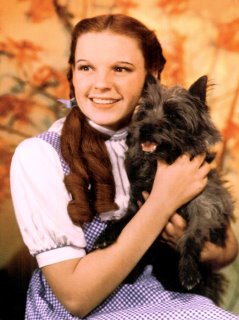

There is much to be said about a film that reports on the basic human need to rediscover our hearts desires in our own backyards. What Frank Lyman Baum’s book The Wizard of Oz did for childhood daydreams, MGM’s colossal three million dollar super production of 1939 recreated on a much broader canvas for the hearts and minds of both the young and the young at heart.
The film’s prophetic introduction, proclaiming “time has been powerless to put its kindly philosophy out of fashion” has since served to best summate the cultural impact Oz has had on lasting human ideals in progress and faith. Time does strange things to our collective memory. What in retrospect seems a foregone and rather straight forward conclusion to a great story, masterfully inspired and winningly told on celluloid, was in fact a series of critical and financial missteps; some outright and abysmal failures. The truth behind The Wizard of Oz is that it blossomed from blind faith, a sense of critical timing and a lot of great good luck.
Frank L. Baum’s stories of that mythical land over the rainbow had a rather auspicious debut. They began as minor amusements in his parlor, told for the benefit of his children and their friends. Baum was born to an affluent family in Chittenango New York on May 15, 1856. But personal success eluded the effervescent showman and story teller once he left the family fold to strike out on his own.


After settling into an editor’s position in Chicago in 1899, Baum began writing his thoughts down on paper. In his spare time he became a minor sensation with the local neighborhood children who flocked to hear his miraculous off the cuff adventures of Dorothy and her companions. The legend goes, that during one of these storytelling sessions a young inquisitive asked Baum to define the land where all his creations dwelt. Perplexed and in search of an answer, Baum’s gaze rested on his filing cabinet, the top drawer with a plate affixed that read ‘A-N’ the bottom; ‘O-Z.’ Whether there is any truth to this folklore remains a curious mystery.
However, by 1900 Baum’s debut book The Wonderful Wizard of Oz had become a runaway best seller prompting publishers Reilly & Lee to suggest its author create a serialized adventure. Eager to capitalize on the book’s success, Broadway impresarios, Fred Hamlin and Julian Mitchell launche
 d their own 1902 production; a reconstituted flashy – if misguided – musical comedy more attuned in sentiment and tastes to unrelated Vaudevillian hokum than Baum’s original clairvoyance for epic fantasy. Arguably an artistic misstep, Oz’s debut in live theater nevertheless created a minor sensation, running a then record 293 performances before going on a country-wide tour that lasted until 1911.
d their own 1902 production; a reconstituted flashy – if misguided – musical comedy more attuned in sentiment and tastes to unrelated Vaudevillian hokum than Baum’s original clairvoyance for epic fantasy. Arguably an artistic misstep, Oz’s debut in live theater nevertheless created a minor sensation, running a then record 293 performances before going on a country-wide tour that lasted until 1911.Despite these overwhelming successes, the specter of Baum’s youthful mediocrity remained a chronic hindrance throughout his later years. Though his follow up novel, The Land of Oz was another publishing milestone, the Broadway incarnation ‘The Woggle Bug was a complete and utter failure. So too did Baum’s skilled fantasy novels apart from the Oz legacy; The Sea Fairies and Sky Island prove disappointing and unpopular with his readership. Between 1912 and 1919, the year of his death, Baum penned one Oz novel per annum. He also founded the Oz Film Company in 1914 that made a few Oz shorts, strained his financial security and ultimately proved disastrous ventures outside the scope of his insular publishing success.
As early as 1924, Baum’s son had proposed a film deal to Metro-Goldwyn-Mayer (MGM) – an ambitious endeavor that never developed beyond the negotiation stage. The following year, a silent version of Oz did
 emerge from independent Chadwick Films. But the movie veered wildly beyond the scope and intelligence of the original work and proved a quick and easily forgotten flop.
emerge from independent Chadwick Films. But the movie veered wildly beyond the scope and intelligence of the original work and proved a quick and easily forgotten flop.In the early 1930s, Samuel Goldwyn went to great pains to launch a lavish super production of his own that would have starred Eddie Cantor as the scarecrow and Helen Hayes as Dorothy. Although Goldwyn had paid forty thousand dollars for the rights to produce Oz, after much ballyhoo the project was quietly shelved.
MGM briefly toyed with the idea of making a series of cartoons based on Baum’s novels. MGM publicist Howard Dietz conducted a poll as to the feasibility and appeal of such a venture. He found none. However, what he soon discovered was that there just might be a market for Oz as a live action fantasy.
No comments:
Post a Comment